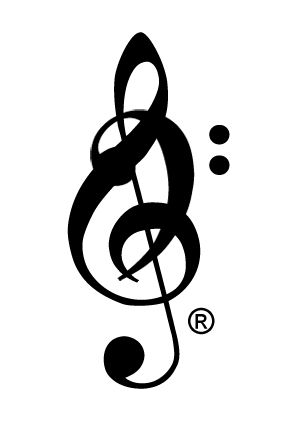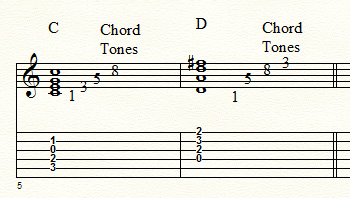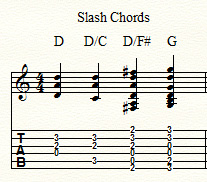 |
|
| HOME / BACKSTAGE |
| Previous Lesson |
Lesson Table of Contents
|
Next Lesson |
These topics will start to take us more into the realm of music composition rather than purely music performance.

From an academic viewpoint, chords are stacked from the bottom up. A simple chord would be stacked as the root note (1), a third (3), a fifth (5), and maybe an octave note (8). Due to the common tuning method of a guitar, that academic viewpoint does not get directly applied to a guitarist. To the new guitarist, this might seem...
Many guitar players will play chords and different inversions of chords without being conscious of the true definition of the chord. Most of the time, no one cares what the REAL name of the chord is (certainly not during a live performance). They care about...
<filtered content>
Let's get started playing some inversions and getting the sound and feel of them. For starters, play these on your clean channel so you can really understand the true nature of each inversion. The dirty/overdrive channel muffles out the details and won't paint the harmonic picture you need for a complete understanding of the structures. There is always time later on, to go blasting away with the distortion.
<filtered content>
After you familiarize yourself with the Chord Inversions, you can try them on your dirty channel and with a combination of RH palm muting and arpeggiated picking (one note at a time through the chord) you can start to dissect the chords and figure out how you would like to use them. By holding the chord with the LH...
When playing tunes, you would mix these chord voicings together. One of the driving forces of which inversion you choose is determined by the bass note of your lines. If you are descending a bassline mixed with chords, you would most likely select whatever inversion of each chord that keeps the lowest note of the chord moving in a linear fashion. Meaning, you would keep your bassline moving with notes in close proximity and laying the appropriate chords atop the bassline. Using this method will make the choice for you as to which inversion you are going to use for each chord. The following samples are some very common uses of chord inversions.
<filtered content>

Oftentimes, players use chord inversions without about aware of it. As you progress down the road of intellectual music development, you will choose to break a chord up into piece-parts and in the process use alternative inversions. While you are implementing chord inversions, you might also end up adding a note to your chord that is not exactly related to that chord. These extra notes can be strummed on the chord or picked separate from the chord. When it is strummed with the chord it is usually called a "slash chord". The following page contains several samples of slash chords.
<filtered content>
In some of the previous slash chord samples you heard what is referred to as passing tones. We will elaborate on passing tones in the next section.
Passing Tones are used to lead from one chord into another chord. They are used "in passing" which is how their name was derived. Players and composers use passing tones all the time. Yet, they might not know what they are called or they might not realize they are using them. They simply know, for instance, to go from a Bm down to a G (on a guitar) it sounds good to play a Bm, then a Bm/A (A bass note), following by a G. In this case, the Bm/A is a B minor chord with the open A string substituting the B root note. This open A string is called the passing tone. As stated in the previous section, if we strummed all the notes together then this would be called a slash chord. In the case of passing tones, we would strum or pick the A separate from the Bm chord. Most likely, you would strum the Bm chord first and then thrown in the open A string just before you strum the following G chord.
While passing tones can be used in the harmony section, the main purpose is to use them in the melody and lead line. If we did not use passing tones, then all melodies of the world would be based strictly on chord tones and everything would sound like arpeggios (or broken chords). The most obvious example of mostly arpeggio playing is a banjo player. For the most part, they hold a chord with LH and then alternatively pick through the individual chord tones with the RH. It was not until much later that chromatic and scale oriented banjo playing became more popular. Anyhow, back to the guitar world... When we play a melody or a fast scale passage over any given chord progression, in terms of simple harmony, approximately half of the notes are matching chord tones and the rest are all passing tones. [For the sake of simplicity, I will not go into Jazz harmony or theory at this time.] Knowing this rule, we can then start building clever lead lines when we know which of the tones are chord tones and which are passing tones. Using the aforementioned B minor example, the Bm chord consists of B,D,F# and the G chord consists of G,B,D. The A was used as the transition tone between Bm and G.
It is also worth mentioning that the tones that are considered passing tones at one moment in time will swap to chord tones the next moment. The ruling over a chord tone or passing tone is determined by... [...] I will use A minor scales and one of my composition passages to illustrate the point.
<filtered content>
The main point is that passing tones are the tones which fall outside the current chord structure. Stated another way...
Pedal tones are used to establish a single stable note in combination with alternate chords and inversions. The phrase "Pedal Tone" originated with organists who would hold down a single foot pedal note and then play different chords on the keyboards above (called manuals). In this modern lesson setting...
<filtered content>
Live lessons can include endless examples of all the concepts in this lesson section as well as other lesson sections. Shop here for live instruction.
| Previous Lesson |
Lesson Table of Contents
|
Next Lesson |

Home / Terms / Privacy / Security / Contact / Help / Listen
Questions or Comments? Info@OtwellMusic.com
Copyright © Ⓟ 2024 Andrew T. Otwell/Otwell Music, LLC. All rights reserved.